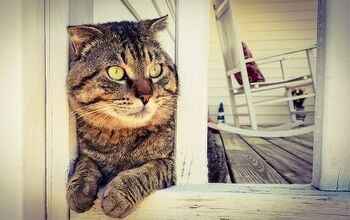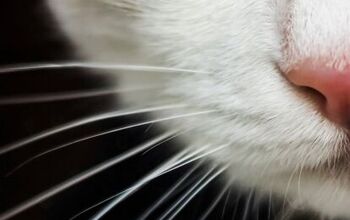5 Colorful Facts About Calico Cats

Calico cats are unmistakable kitties with a unique coat pattern that many people instantly fall in love with. With a particular mix of colors and unique patterns, these graceful felines are an eye-catching sight- it would be difficult not to be completely captivated by the graceful looks of calico kitties. But there’s more to these cats than just good looks. Check out some of the most interesting facts about these pretty felines below.
What Makes a Calico a Calico
Calico refers to a coat pattern, not a feline breed, so there are many breeds that can feature this pattern. Turkish Van, Siberian cats, Norwegian Forest cats, bobtail, shorthair, Manx cats, or Maine Coons – it matters not. They – and many others – can all display the colorful and charming calico pattern. Basically, a calico cat will have a tri-color coat, which means there are at least three colors within the animal’s fur. Often, these three colors are the basic black, orange, and white, but variations of these colors could also be present. This unique look is quite similar to the famed Calico fabric, a textile that originated in the Indian city of Calicut – and hence the nickname for these cats. The same name is given to the Calico Goldfish, which also boast a similar color scheme.
Related: 5 Interesting Facts About Tabby Cats
Also, calico kitties are different from tortoiseshell kitties. While torties could have orange and black in their coat – with tiny pattern variations and a full coverage – regular calico cats will typically be mostly white, often around the chest and belly, and will have patches of color throughout the coat. Your “ordinary” calico kitty will have a white neck, chest, and belly, a deep black back and head – with quirky tabby and orange patterns mixed throughout. You really can’t miss them!
The Origin of the Calico Cat
Experts aren’t entirely sure about when and where calico kitties first appeared. However, some think that these cats were found in Egypt first. It is possible that the cats were later taken to port cities in France, Spain, and Italy, from where they spread out all over the world. Regardless of where these beautiful cats came from, though, they are now a common sight wherever kitties are found. Of course, crucial for their spread was their mutant gene, and not their numbers. The Calico look and pattern are genetic, and it’s that gene that is shared with tortoiseshells cats. Still, calicos have that unique “spotting” mutation that gives their coat such a unique pattern.
Calico is just a coat pattern that can be found across several feline breeds, so it will not have an influence upon a kitty’s personality. Plus, every animal is an individual, so every calico will be different. Generally, though, you can expect that calicos, like other kitties, will be friendly, social, and loving when they are treated with kindness and given a safe and secure place to call home. But where personality can’t be affected by the calico pattern, the looks can. You can expect a calico kitty to look either serious, goofy, or graceful. A different pattern mix can land orange spots on the eyes, the mouth, or anywhere else – in unique arrangements. This can sometimes result in a true unique looking kitten.
Related: Facts And Myths About Black Cats
It’s Hard to Find a Male Calico
More often than not, when you come across a calico, it will be a girl. For example, you might only get one male calico for every 3,000 calicos that are born. This is because the black and orange pattern of patches on the coat is associated with the X chromosome. In order for a kitty to showcase the distinct tri-color coat of a calico, two X chromosomes are required.
Female kitties have two X chromosomes, while males have the XY chromosome pair. Therefore, calico males are rare, as they are the result of having an XXY configuration, which is associated with Klinefelter’s Syndrome, a condition that causes them to be sterile as well. The same goes for Tortoiseshell kitties too – males are rare, and usually sterile. Still, this unique aspect won’t stop you from absolutely adoring your four legged calico buddy.
Calico Cats Are Considered Lucky Cats
In certain parts of the world, such as in Japan, calico kitties are thought to bring you good luck. There, they are known as mikeneko (三毛猫) – the “triple fur cat” – and are widely loved by everyone. Even the maneki-neko, or the “beckoning cat” – is traditionally a calico. What is more, Japanese sailors over the centuries traditionally brought a calico kitty with them on long sea voyages. As a ship’s cat it was considered to bring protection against misfortune! And in places like the United States and the United Kingdom, some people believe that male calicos bring good luck because they are so rare. In Germany, the calico cats are widely known as the “Glückskatze” or “lucky cats”. But we like to think that receiving the love of any cat, regardless of breed or coat pattern, makes a person lucky. Did you know that the calico is the state cat of Maryland? They were chosen for this role as they share the color patterns with other state animals – the Baltimore checkerspot butterfly, and the Baltimore oriole.
Calico cats are certainly beautiful and interesting. They also come as dilute calicos, a variety with lighter colors and different variations. Instead of the usual black, orange, and white, dilute calicos boast a mix of grey, cream, and gold colors. Of course, they are equally as beautiful. If you’re like so many others who have seen a unique calico and decided that you’d like to add one to your family, consider adopting from your local animal shelter, as there are plenty of calicos who are looking for a forever home. You will discover that they make wonderful companions – just like all other feline friends.

Lisa Selvaggio is a freelance writer and editor, and our resident cats-pert, with certifications in pet nutrition and pet first aid. She enjoys producing content that helps people understand animals better so they can give their pets a safe and happy home.
More by Lisa Selvaggio























